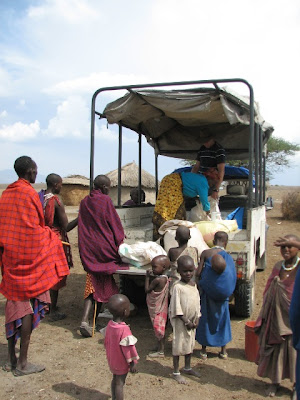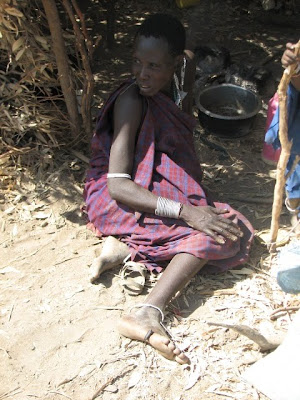Graham writes: We started the safari buying some Kenyan cows for the project – better stock and one a young bull calf for breeding purposes. The man was quite reticent but when we started bargaining he came alive, like most Maasai do, to extol the virtues of his cows and why they should be such a high price!
We put our usual marks on the animals that we had bought - the Laiser clan markings across the face and the Big ‘G’ on the rump.

We drove up the Rift Valley and cut across country into the dust.

As we drove near one boma, a young man and a load of children ran out begging for water. Their womenfolk had gone off in the morning and not yet returned. It was after 4 pm and they had had no water. Most of them had been sleeping to pass time and conserve energy. Lekoko opened up the maize sack and gave them some - about 40 kilos - and then gave them water which was gulped straight down.
Everyone was happy and waved us off thanking us and God profusely. It must have been so unreal for them that a couple of white men would come over the hill with food and water out of nowhere. We were to experience this again in several other places.

As the light was fading on that first night, we set off towards Saigare’s boma with him showing us the way. He began to take us through trees and dry river beds while he and Lekoko ran ahead in the headlights to make sure that the Land Rover could get through. A man who is used to walking everywhere and doesn’t know how to drive isn’t the best person to choose the path ahead in my experience! It was incredibly dry and dusty with a terrible following wind that obliterated everything from time to time.
In the end even Saigare lost his way home and asked us to stop and turn the headlights off. Way behind us we could see a dim torch light which was the boma signalling to us that we had passed so we did an about turn and found them. It is a ronjo boma - a dry season temporary boma - made up of a thorn fence and huts of leafy twigs through which the wind and dust blew mercilessly.

Luckily we were given a sheltered spot behind one of these with a couple of cowhides on which to put our mattresses.
Despite the late hour Saigare wanted to kill a goat for us. We had fallen asleep when someone came round with the liver so we chewed briefly through it with our host. We slept again and were woken up a second time for the meat! Sleep was again interrupted when some moran (warriors) came to the camp late and woke up the woman in the ‘hut’ right next to our heads asking for chai. They talked and joked whilst it was being prepared and drunk. There is no whispering in Maasai except to tell secrets it seems. Apart from that we only heard the laboured breathing of a baby with a bad cold!

The dawn was a wonderful display of light and warmth, although I tried hard to keep my eyes closed and catch up on my sleep. When I did open them I found an audience of four women standing watching me!

I soon forgave them when I had a cup of hot chai in my hand, which I make a habit of sharing with the children so we had an attendant flock of eager-eyed young ones. One of them was told to greet us and then between deep shy gasps gave us all the news of the boma, just as a grown man would do, whilst his father watched proudly in the background!

Next stop was the wells where they water their cows. The wind was still blowing relentlessly whipping up clouds of dust as the various flocks headed off in search of patches of grass to eat. The cows are being hit hardest as they need grass whereas the goats can graze on young leaves off the trees. We came across dead cows along the cow trails in many places.

It is reputed that the British dug the first wells to help the Maasai who have continued digging them since then. Each one is variously owned by a group of men with bomas and flocks in the vicinity. There is a small group of young men from other tribes who live and work here doing all the digging on contract. Saigare’s well had run out of water the night before so he had asked to water his cows at a neighbour’s well. He waters the cows in the evening and the goats and sheep in the morning. The water is thrown up in a half galloni - about 10 litres - in three hands up to the trough where the animals come down a path to drink.



Saigare showed us the skull of a hyena he had killed. It had large heavy incisors a couple of flat topped teeth and the back teeth which should have been molars were incredibly sharp and long single teeth. He took us to where he had tied up a piece of cow hide through which he had threaded two sharp sticks with meat on. Directly below it he had dug a stake into the ground and tied his sime (bushknife) to it pointing upwards. The hyena had come along and jumped up for the meat and come down right on top of the sime. Suddenly Saigare was grunting fiercely and running backwards and forwards waving his stick and sime agressively. He was apparently showing us how he saw off a lion that had come after his goats - very impressive show of psychological testosterone! I’ve often wondered what I would do if I met a lion. Statistically it has to happen at some stage if I keep going out into the bush.

We set off again through blinding sand finding a new way through the scrub. We had just cleared the thick scrub when the exhaust came apart and the engine started to roar so we made for a tree and cooked up some tea. I managed to make something up from a tree root and with Lekoko’s help we tied it in place - it lasted until I fixed the thing properly a week later!

At our final stop we found it was market day and as we were desperate for some water and to have a good wash we also headed for the water trough. We stayed again in Norikito’s boma in a hut that was partially built and very comfortable.


Jenny and Lisa joined us here and arrived just in time to dance with the women whilst the men slaughtered the goat under a tree out of sight of the boma - morans (warriors) can’t eat meat that has been seen by a woman.
We were given a portion that we set out on some leaves and sat and ate with the men of the surrounding bomas. It was very tender and we all relaxed and enjoyed it.





















































